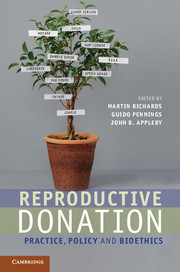Book contents
- Frontmatter
- Contents
- Contributors
- Acknowledgements
- 1 Introduction
- 2 The biology of donation
- 3 Ethics for reproductive donation
- 4 Parenthood – whose right is it anyway?
- 5 Reproductive donation
- 6 UK and US perspectives on the regulation of gamete donation
- 7 Gamete and embryo donation
- 8 The legal and ethical regulation of transnational donation
- 9 Balancing ethical criteria for the recruitment of gamete donors
- 10 Challenges in intra-family donation
- 11 ARTs and the single parent
- 12 Reproductive donation and justice for gay and lesbian couples
- 13 Is disclosure in the best interests of children conceived by donation?
- 14 Identifiable donors and siblings
- 15 Ethical issues in embryo donation
- 16 Reproduction through surrogacy
- 17 Some conclusions regarding the interaction of normative and descriptive elements in reproductive donation
- Index
- References
8 - The legal and ethical regulation of transnational donation
Published online by Cambridge University Press: 05 August 2012
- Frontmatter
- Contents
- Contributors
- Acknowledgements
- 1 Introduction
- 2 The biology of donation
- 3 Ethics for reproductive donation
- 4 Parenthood – whose right is it anyway?
- 5 Reproductive donation
- 6 UK and US perspectives on the regulation of gamete donation
- 7 Gamete and embryo donation
- 8 The legal and ethical regulation of transnational donation
- 9 Balancing ethical criteria for the recruitment of gamete donors
- 10 Challenges in intra-family donation
- 11 ARTs and the single parent
- 12 Reproductive donation and justice for gay and lesbian couples
- 13 Is disclosure in the best interests of children conceived by donation?
- 14 Identifiable donors and siblings
- 15 Ethical issues in embryo donation
- 16 Reproduction through surrogacy
- 17 Some conclusions regarding the interaction of normative and descriptive elements in reproductive donation
- Index
- References
Summary
Introduction
This chapter provides an overview and analysis of the phenomenon of transnational donation, an aspect of donation practices which has grown both in prevalence and significance over the past decade. After defining what we mean by ‘transnational donation’, we interrogate this phenomenon from different perspectives in three different sections. The first section surveys the empirical evidence and available data on transnational donation and cross-border reproductive care (CBRC), first with regard to the movements of patients and second with regard to the movements of gametes across borders. The second section analyses the potential regulatory approaches that may be developed as a response to transnational reproduction, investigating in turn the pros and cons of coerced conformity, international harmonization and moral pluralism. The final section evaluates the three main ‘dangers’ of CBRC – to safety, to autonomy and to justice – and analyses the ethical force, accuracy and strength of each of these arguments.
What is ‘transnational donation’?
Transnational donation is one aspect of the newly emerging, and rapidly developing, phenomenon of CBRC. CBRC refers to movements across national borders to seek or facilitate infertility treatments. Within this broader phenomenon the term ‘transnational donation’ is reserved specifically for the pursuit of treatments involving the use of donor gametes. Although CBRC covers a wide range of assisted reproductive technologies (ARTs) – for example, pre-implantation genetic diagnosis (PGD) – infertility treatments involving donation make up a large subset of the CBRC market. This is because ARTs involving donor gametes are subject to great diversity between jurisdictions with regard both to the level and nature of regulatory control and to the availability of necessary resources (see Chapter 5, Chapter 6, and Chapter 7). It is the prevalence of such diversity, even among countries in close geographical proximity to one another, that drives transnational donation and makes it a very significant aspect of the broader CBRC phenomenon.
- Type
- Chapter
- Information
- Reproductive DonationPractice, Policy and Bioethics, pp. 130 - 149Publisher: Cambridge University PressPrint publication year: 2012
References
- 4
- Cited by



